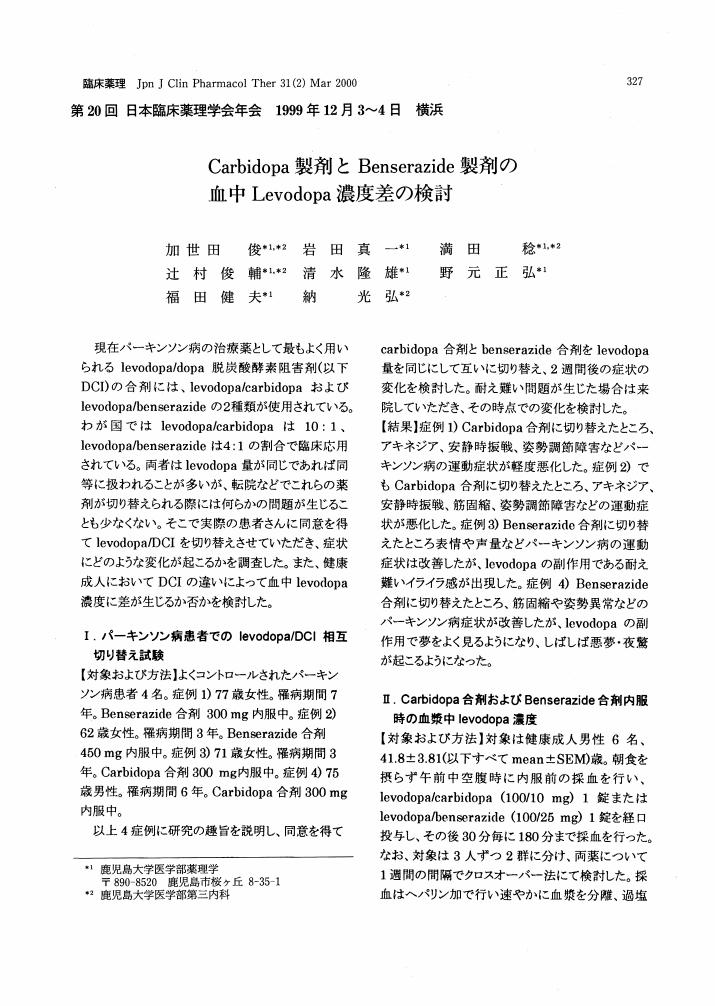4 0 0 0 OA カルビドパ合剤とベンセラジド合剤の違いによるパーキンソン病患者L―ドパ血中濃度の変化
- 著者
- 永井 将弘 張 捷 中塚 晶子 矢部 勇人 野元 正弘
- 出版者
- 一般社団法人 日本臨床薬理学会
- 雑誌
- 臨床薬理 (ISSN:03881601)
- 巻号頁・発行日
- vol.35, no.1, pp.231S, 2004-01-31 (Released:2010-06-28)
- 参考文献数
- 1
- 著者
- 安藤 利奈 山崎 知恵子 岩城 寛尚 辻井 智明 矢部 勇人 西川 典子 永井 将弘 野元 正弘
- 出版者
- 一般社団法人 日本臨床薬理学会
- 雑誌
- 臨床薬理 (ISSN:03881601)
- 巻号頁・発行日
- vol.48, no.5, pp.167-171, 2017-09-30 (Released:2017-10-28)
- 参考文献数
- 11
- 被引用文献数
- 2
Parkinson's disease (PD) causes motor impairment, but motor dysfunction can be improved by treatment. However, the package inserts of PD therapeutic drugs state “do not drive a car” as an important precaution in Japan. In addition, the package insert of non-ergot dopamine agonist (DA) states specifically “do not drive a car or operate a machine” as a warning because non-ergot DA causes sudden sleepiness and somnolence. On the other hand, driving is a very important means of transportation for daily living and work. Even though doctors explain at the clinic that the patients should not drive while on medications, many patients are forced to drive in everyday life. In addition, somnolence and sudden sleepiness differ among individuals. Therefore, doctors are confused about instructing patients to refrain from driving. We investigated the relation between non-ergot DA and driving situation in PD patients, which is a serious issue in the clinical setting. All 362 PD patients who visited our offices were interviewed regarding their driving situation, and detailed medications and car accidents were examine in 154 patients who continued driving a car or stopped driving after the onset of disease. In the investigation of medications, 51 patients were taking non-ergot DA, 36 patients (70.6%) of whom continued to drive. In addition, 20 of 154 patients had serious car accidents, but only six of the accidents were associated with somnolence and sudden sleepiness. In the examination of medications at the time of accident, there was no difference between non-ergot DA and other medications. These results suggest that upon receiving instructions from healthcare professionals, PD patients drive while making appropriate judgment about medication-induced somnolence. However, in this study, the number of patients who experienced serious car accidents was small, and the numbers of patients taking ergot DA and non-ergot DA were limited. Further larger scale study is required to confirm the findings. Preparation of guidelines related to instructions on taking PD medications is necessary, which include medication taking during holidays, consideration of the occurrence of sudden sleepiness and somnolence, and judgement of whether to continue driving.
2 0 0 0 OA 尿酸と脳神経疾患
- 著者
- 野元 正弘
- 出版者
- 一般社団法人 日本痛風・尿酸核酸学会
- 雑誌
- 痛風と尿酸・核酸 (ISSN:24350095)
- 巻号頁・発行日
- vol.44, no.1, pp.1-6, 2020-07-25 (Released:2020-07-25)
1 0 0 0 OA 2.中枢神経障害の機序
- 著者
- 野元 正弘
- 出版者
- 一般社団法人 日本内科学会
- 雑誌
- 日本内科学会雑誌 (ISSN:00215384)
- 巻号頁・発行日
- vol.96, no.8, pp.1580-1584, 2007 (Released:2012-08-02)
- 参考文献数
- 4
- 被引用文献数
- 1
薬物による中枢神経障害は,主作用を介している中枢神経受容体が治療域以上に刺激され,強い薬理作用が生じたために起こる副作用と,中枢神経内での薬物濃度が高くなり,通常の治療時には起こらない作用が生じて中枢神経が障害されるものがある.前者は主に中枢神経作用薬でみられ,多くは可逆性で減量により軽快,消失するが,後者は抗ガン剤や免疫抑制薬で見られることが多く,投薬を中止しても回復しないことが多い.
1 0 0 0 OA Parkinson病治療薬と日中の眠気・突発的睡眠との関連についての検討
- 著者
- 安藤 利奈 多田 聡 宮上 紀之 矢部 勇人 野元 正弘 永井 将弘
- 出版者
- 日本神経治療学会
- 雑誌
- 神経治療学 (ISSN:09168443)
- 巻号頁・発行日
- vol.36, no.3, pp.317-320, 2019 (Released:2019-11-25)
- 参考文献数
- 8
Parkinson disease(PD)患者では日中の過度の眠気がみられることがあり,そのリスク因子としてPD治療薬の関与が報告されている.今回,PD患者の内服薬と眠気について調査するため,当科を受診したPD患者に対しEpworth Sleepiness Scale(ESS)を施行し,PD治療薬との関連について検討した.ESSスコアはPD治療薬総量,罹病期間,PD重症度と有意な正の相関を認めた.Dopamine agonist(DA)使用患者はESSスコアがDA未使用患者よりも高かった.原因としてDA使用患者はPD治療薬総量が多く,総量増加に伴うESSスコアの上昇が考えられた.また,突発的睡眠はDA使用患者,未使用患者共にみられ,突発的睡眠を認める患者でESSスコアが高い結果が得られたことから,全てのPD患者で突発的睡眠に注意が必要であり,ESSスコアが突発的睡眠の指標になることが示唆された.


